Flatbreads and Flavors by Jeffrey Alford and Naomi Duguid represents a dream job for me - and probably most of us - travelling the world and sampling authentic cuisine so you can write a cookbook that will be widely acclaimed and loved by all. This book is wonderful and is as much travelogue as it is recipe book. We decided to sample a Georgian recipe for cheese boat breads. As they described these, they were presented as something resembling a deep-dish cheese pizza. This can leave a bit of a false impression, as their version is not overpowered by the cheese. This bread is a great snack or appetizer and could easily push aside garlic bread, breadsticks or crostini. Even better, you could easily make a meal by adding a simple green salad.
The recipe will make four boats - I successfully halved the recipe with no problem to make only two boats.
[i]2 cups warm water[/i]
[i]pinch of sugar[/i]
[i]2 tsp. dry yeast[/i]
[i]5 to 6 cups hard unbleached white flour or unbleached all-purpose flour[/i]
[i]2 tsp. salt[/i]
[i]1 Tbs. olive oil[/i]
[i]FILLING[/i]
[i]6 oz. soft young goat cheese, at room temperature[/i]
[i]2 oz. Gruyere, coarsely grated[/i]
[i]1/4 cup plain yogurt[/i]
These were my ingredients (water and sugar not pictured):
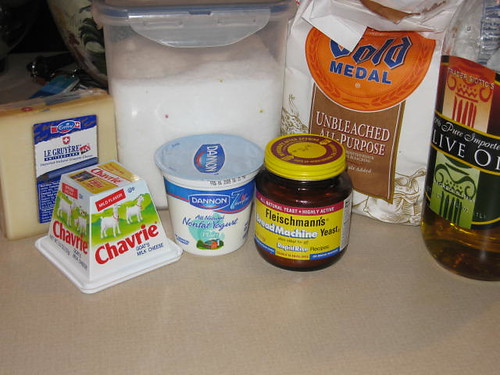
In my version, I've used unbleached AP flour and I am getting through the Fleishman's "bread machine" yeast which is just faster acting, so I need to check my rise at half the time listed in the recipe.
INSTRUCTIONS:
[i]You will need a large bread bowl, a medium-sized bowl, unglazed quarry tiles to fit on a rack in your oven, a baker's peel or two baking sheets and a rolling pin (optional).[/i]
[i]Place the warm water in a large bowl, stir in the sugar and the yeast, and let stand for several minutes until the yeast has dissolved. Then gradually add 2 1/2 cups flour, stirring constantly in the same direction, about 1 minute, to develop the gluten. Sprinkle on the salt, add the oil, and continue adding the flour and blending it onto the dough until it is less sticky.[/i]
I've taken to using one of my silicone spatulas instead of a wooden spoon for these jobs - it seems to stick less and mix more. It could just be a psychological thing too:

[i]Turn the dough out onto a floured surface and knead for 10 minutes, until smooth and elastic, with a slight sheen. Form onto a ball, and place in a lightly oiled clean bowl or on a lightly floured surface to rise, covered with plastic wrap, until doubled in volume, 1 1/2 to 2 hours.[/i]
This was my rise after an hour:
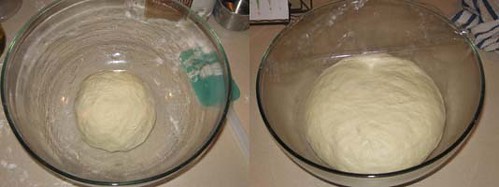
[i]Preheat the oven to 450 degrees. If using quarry tiles, arrange on the bottom oven rack, leaving a 1-inch gap between the tiles and oven walls. If not, lightly oil two baking sheets.[/i]
[i]Gently push down the dough. On a lightly floured surface, using a sharp knife, cut the dough into 4 equal pieces. Flatten each piece out with the lightly floured palm of your hand, then cover with plastic wrap while you prepare the filling.[/i]
Since I'd halved the recipe, I only had two pieces - that's a standard cookie sheet that they're resting on at the moment. I should also note that I have a round pizza stone - I had the stone in the oven getting hot while the oven preheated:
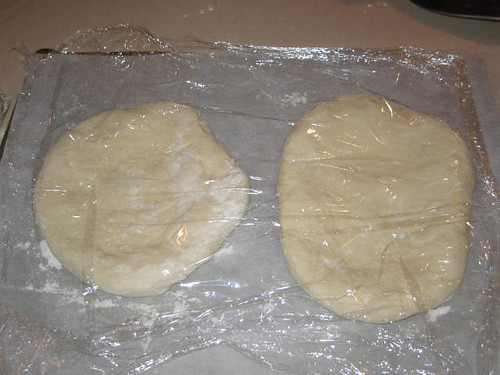
[i]Place the cheeses and yogurt in a bowl, and blend together to a smooth consistency.[/i]
This is very straightforward (although "smooth" is relative since you're supposed to start out with coarsely grated Gruyere). What I will say is that for the bite that each of these ingredients has separately, they come together and seem almost sweet. Husband said it almost reminded him of cheese danish filling.
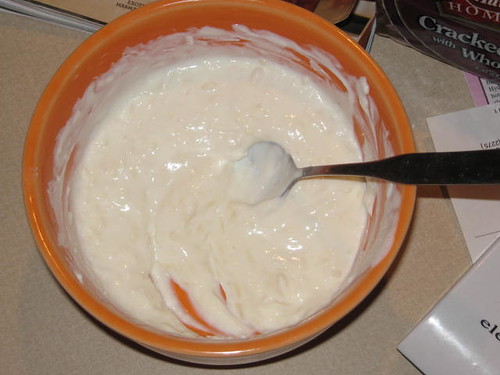
[i]Work with one piece of dough at a time, leaving the remaining dough covered with plastic wrap. With your hands or a rolling pin, stretch and flatten the dough in to a long oval 8 to 10 inches long, 5 to 6 inches wide, and no more than 1/4 inch thick. Place a generous 1/4 cup filling in the center of the oval. Spread to within an inch of the edges. Roll the edges over to make a thick rim, pinching the sides together to form a point at the ends. (The bread should look boat-shaped.) Shape and fill a second bread. Slide the breads onto a peel and then onto the quarry tiles, or slide onto the baking sheets and place on the bottom oven rack. Bake until the crust is golden and the bottom is firm and crusty, about 12 to 15 minutes. Wrap in a towel to keep warm while you prepare and bake the remaining two breads the same way. Serve hot.[/i]
The construction took less than 5 minutes per boat:

I only did one boat at a time, as my stone is smaller. The bake time was about 14 minutes for each. The puff was gorgeous:
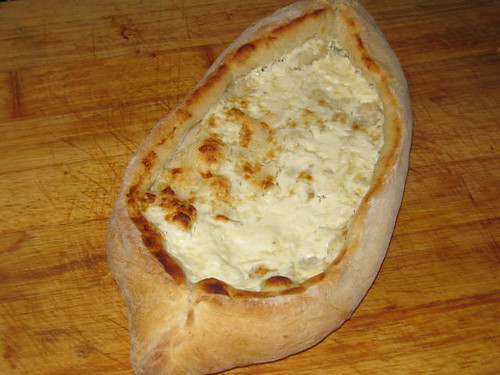
Before I forget - crumb:

The cheese really complimented the bread and was great stand-alone, although we probably came up with quite a few variations right away. We thought a sea salt wash on the crust might be a nice add right off the bat (more for appetizers). Fresh herbs mixed with the cheese were very obvious. Very light additions of tomatoes, grapes, golden raisins, figs - anything that wouldn't turn into a heavy pizza - seemed like something worth trying with this bread.
If you haven't been lucky enough to try items from Flatbreads & Flavors, this is one of the many reasons why the book is worth checking out!
- Stephmo's Blog
- Log in or register to post comments
look awesome! You just can't go wrong with cheese and bread. I can see where you could have alot of fun with this..so many variations. Thanks for sharing.
Betty